
|
Soldering Iron Kit |
|

|
arduino IDEArduino
|
DIY Analog VU meter with Arduino peak meter
An analog VU meter, or Volume Unit meter, is a device used in audio equipment to display the level of audio signal in decibels (dB). It is commonly found on audio mixing consoles, amplifiers, and other audio equipment. The primary purpose of a VU meter is to provide a visual representation of the audio signal's amplitude, helping users monitor and control the signal level to prevent distortion or ensure proper recording and playback. Despite the prevalence of digital meters, analog VU meters are still appreciated for their nostalgic and classic appearance, and many audio enthusiasts prefer their aesthetic and the way they visually represent audio signals.

Unfortunately even nowadays these instruments are relatively expensive and their price is higher than several hundred dollars. This time I will present you a way to make such an instrument yourself, which according to the characteristics does not lag behind commercial devices of this type.
The most expensive part of these Vu meters are of course the galvanometers which are actually precision microammeters with a moving needle. Such instruments were commonly used in sound recording devices manufactured at the end of the last century and can easily be found in electronic waste disposal sites.

This project is sponsored by PCBway. This year PCBway is celebrating the 10th anniversary of its successful existence. On the occasion of this event, PCBway provided its users with more conveniences such as big savings for certain products, as well as discounts of up to 80%. From July 1st to July 31st, log in to the PCBway site, and start the PCBway 10th Anniversary Tour, where you will enjoy Coupons, Lucky Draw, Exclusive Badges, unboxing blind boxes, and many other surprises. PCBway is always your great choice.

In particular I bought for $10 an old defective UHER 4200 Record Monitor tape recorder that contains two marked round VU meters with a built-in backlight. These instruments need to be connected to an audio signal source in some way.

For this purpose is used an electronic circuit (driver), which can be of passive or active type. The passive driver is simple to build but is relatively insensitive because you must overcome the voltage drop of the diodes with the signal. In that case, they are usually connected to the output of the amplifier and represent power meters.

An active driver contains ICs or transistors as an amplifier, and despite the fact that it is very sensitive, has a high input resistance and does not affect the source signal at all. n this particular project I will use two identical active drivers for both channels.

The device is relatively simple to build and consists of several parts:
- Two microamp meters,
- an operational amplifier IC (I used TL081, but another similar one can be used),
- some passive elements (capacitors, resistors and diode)
- and a potentiometer that changes the input sensitivity, and serves to calibrating the VU meter.

I also added a peak meter circuit, whose function is each time when the signal exceeds the specified level, turns on RED led. It was easiest for me to use an microcontroller for this purpose, because I can very simply and precisely set the activation threshold of the LED in the code. This is an Arduino Nano clone that costs less than $2 and doesn't add much to the cost of the device. Of course, if you have no experience with microcontrollers, you can make a very simple peak meter with transistors.

If we use the VU meter as an independent device as in my case, there is no need for calibration and the sensitivity can be adjusted with the potentiometer. Another option is to embed it in some audio device, for example between the preamplifier and the output amplifier, in which case we need to calibrate using a reference calibrated VU meter.
And now let's see how the device works in real conditions: We take the audio signal from the sound card of the PC to the input of the VU meter, and from there it continues to the input of the audio amplifier. In this way, the VU meter shows the level of the input signal, regardless of the intensity of the output volume. For a better visual impression, I made the appropriate rings on a 3D printer, and I installed the entire device in a box made of PVC material with a thickness of 3 and 5 mm and covered with self-adhesive colored wallpaper.

The device is powered by 12V DC.


#define L A0
#define R A1
int sigL = 0;
int sigR = 0;
void setup() {
pinMode(2, OUTPUT);
pinMode(3, OUTPUT);
}
void led() {
sigL = analogRead(L)*5;
sigR = analogRead(R)*5;
if (sigL > 600) {digitalWrite(2, HIGH);} else {digitalWrite(2, LOW);}
if (sigR > 650) {digitalWrite(3, HIGH);} else {digitalWrite(3, LOW);}
}
void loop() {
led();
}


DIY Analog VU meter with Arduino peak meter
- Comments(0)
- Likes(1)
-
 Prasanna K
Mar 21,2025
Prasanna K
Mar 21,2025
- 0 USER VOTES
- YOUR VOTE 0.00 0.00
- 1
- 2
- 3
- 4
- 5
- 6
- 7
- 8
- 9
- 10
- 1
- 2
- 3
- 4
- 5
- 6
- 7
- 8
- 9
- 10
- 1
- 2
- 3
- 4
- 5
- 6
- 7
- 8
- 9
- 10
- 1
- 2
- 3
- 4
- 5
- 6
- 7
- 8
- 9
- 10
 More by Mirko Pavleski
More by Mirko Pavleski
-
 Arduino 3D Printed self Balancing Cube
Self-balancing devices are electronic devices that use sensors and motors to keep themselves balanc...
Arduino 3D Printed self Balancing Cube
Self-balancing devices are electronic devices that use sensors and motors to keep themselves balanc...
-
 DIY 5-Day Rainfall Forecast Device - ESP32 E-Paper Project
In several of my previous projects I have presented ways to make weather stations, but this time I ...
DIY 5-Day Rainfall Forecast Device - ESP32 E-Paper Project
In several of my previous projects I have presented ways to make weather stations, but this time I ...
-
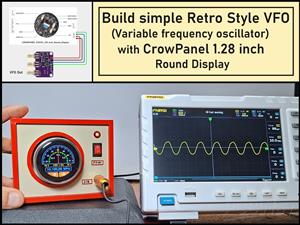 Build simple Retro Style VFO (Variable frequency oscillator) with Crowoanel 1.28 inch Round Display
Today I received a shipment with a Small round LCD display from Elecrow. The device is packed in tw...
Build simple Retro Style VFO (Variable frequency oscillator) with Crowoanel 1.28 inch Round Display
Today I received a shipment with a Small round LCD display from Elecrow. The device is packed in tw...
-
 Human vs Robot – Rock Paper Scissors with MyCobot 280 M5Stack
Today I received a package containing the few Elephant Robotics products. The shipment is well pack...
Human vs Robot – Rock Paper Scissors with MyCobot 280 M5Stack
Today I received a package containing the few Elephant Robotics products. The shipment is well pack...
-
 How to Build a Simple Audio Spectrum Analyzer with Adjustable Settings
An audio spectrum analyzer is an electronic device or software tool that measures and visually disp...
How to Build a Simple Audio Spectrum Analyzer with Adjustable Settings
An audio spectrum analyzer is an electronic device or software tool that measures and visually disp...
-
 How to Make a Digital Clock on a Vintage B&W TV using Arduino
These days I accidentally came across this small retro Black and White TV with a built-in Radio, so ...
How to Make a Digital Clock on a Vintage B&W TV using Arduino
These days I accidentally came across this small retro Black and White TV with a built-in Radio, so ...
-
 Build a $10 Function Generator with Frequency Meter for Your Lab
A function generator is a piece of electronic test equipment used to generate various types of elec...
Build a $10 Function Generator with Frequency Meter for Your Lab
A function generator is a piece of electronic test equipment used to generate various types of elec...
-
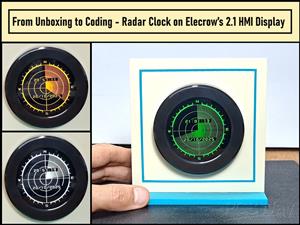 From Unboxing to Coding - Radar Clock on Elecrow’s 2.1 HMI Display
Today I received a shipment with a large round LCD display from Elecrow. The device is packed in two...
From Unboxing to Coding - Radar Clock on Elecrow’s 2.1 HMI Display
Today I received a shipment with a large round LCD display from Elecrow. The device is packed in two...
-
 Making a Retro Analog NTP Clock with Unihiker K10 - Arduino IDE Tutorial
Some time ago I presented you a way to use standard Arduino libraries on the Unihiker k10 developme...
Making a Retro Analog NTP Clock with Unihiker K10 - Arduino IDE Tutorial
Some time ago I presented you a way to use standard Arduino libraries on the Unihiker k10 developme...
-
 Build a Cheap & Easy HF Preselector - Antenna Tuner
HF antenna preselector is an electronic device connected between an HF radio antenna, and a radio r...
Build a Cheap & Easy HF Preselector - Antenna Tuner
HF antenna preselector is an electronic device connected between an HF radio antenna, and a radio r...
-
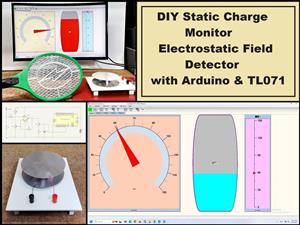 DIY Static Charge Monitor - Electrostatic Field Detector (Arduino & TL071)
A Static Charge Monitor also known as a Static Field Meter or Electrostatic Voltmeter is a device u...
DIY Static Charge Monitor - Electrostatic Field Detector (Arduino & TL071)
A Static Charge Monitor also known as a Static Field Meter or Electrostatic Voltmeter is a device u...
-
 XHDATA D-219 Radio Short Review with complete disassembly
Some time ago I received an offer from XHDATA to be one of the first test users of their new radio m...
XHDATA D-219 Radio Short Review with complete disassembly
Some time ago I received an offer from XHDATA to be one of the first test users of their new radio m...
-
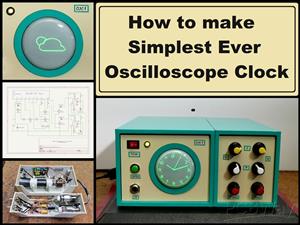 How to make Simplest ever Oscilloscope Clock
An oscilloscope clock is a unique and creative way to display the time using an oscilloscope, which...
How to make Simplest ever Oscilloscope Clock
An oscilloscope clock is a unique and creative way to display the time using an oscilloscope, which...
-
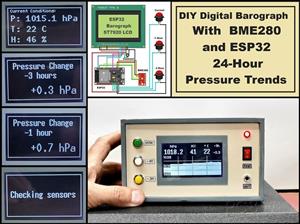 DIY Digital Barograph with BME280 and ESP32 - 24 Hour Pressure Trends
A barograph is a self-recording barometer that continuously measures and records atmospheric pressu...
DIY Digital Barograph with BME280 and ESP32 - 24 Hour Pressure Trends
A barograph is a self-recording barometer that continuously measures and records atmospheric pressu...
-
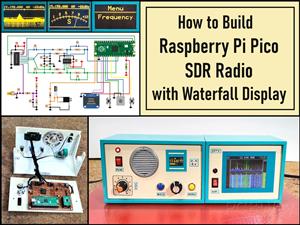 Build a Raspberry Pi Pico SDR Radio with Waterfall Display
Software-defined radio (SDR) is a radio communication system where components that have traditional...
Build a Raspberry Pi Pico SDR Radio with Waterfall Display
Software-defined radio (SDR) is a radio communication system where components that have traditional...
-
 DIY Magnet Polarity Detector - How to Identify Poles with a Hall Sensor from a PC Fan
Recently, while working on a project, I needed to determine the polarity of several permanent magne...
DIY Magnet Polarity Detector - How to Identify Poles with a Hall Sensor from a PC Fan
Recently, while working on a project, I needed to determine the polarity of several permanent magne...
-
 Light Meter Project - Making Dfrobot Unihiker K10 Work with Standard Arduino Libraries
The other day I received a shipment with a UNIHIKER K10 development board from DFRobot, which I rec...
Light Meter Project - Making Dfrobot Unihiker K10 Work with Standard Arduino Libraries
The other day I received a shipment with a UNIHIKER K10 development board from DFRobot, which I rec...
-
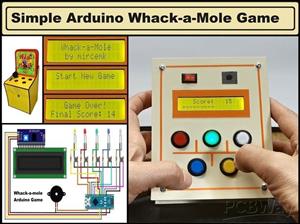 DIY Simple Arduino Whack-a-Mole Game
A "Whack-a-Mole" game is a classic arcade-style game where moles pop up randomly from holes, and th...
DIY Simple Arduino Whack-a-Mole Game
A "Whack-a-Mole" game is a classic arcade-style game where moles pop up randomly from holes, and th...
-
-
AEL-2011 Power Supply Module
515 0 2 -
AEL-2011 50W Power Amplifier
474 0 2 -
-
-
Custom Mechanical Keyboard
691 0 0 -
Tester for Touch Screen Digitizer without using microcontroller
322 2 2 -
Audio reactive glow LED wristband/bracelet with NFC / RFID-Tags
306 0 1 -
-
-












































